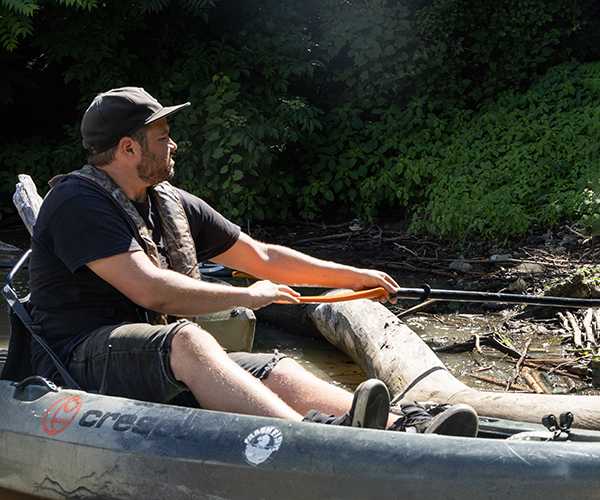Gavin Svenson is the kind of guy who doesn't mind hanging out
in the Amazon lowlands of Peru for two weeks looking for bugs. Actually, this is his thing. He climbs into tree canopies, keeps his eyes attuned for familiar movements on bark, even uses the old hold-a-light-up-to-a-sheet trick and picks off insects as they inevitably get drawn in, much like they do to your porch light on summer evenings.
This is fun for him — even though he's a 4 1/2 hour boat ride away from the nearest city and can only send brief text messages from the field research station each night. Even when the impending rainy season inundates the tropical forest and floods large tracts of land along the river, Svenson shares the tale with a go-figure smile. You see, these are the sort of things that happen when your work is unraveling the mysteries of the praying mantis.
"I had always been really, really interested in them, like a lot of people," says Svenson, curator and head of invertebrate zoology at the Cleveland Museum of Natural History. "They're an insect that can sit on your hand and look at you. They don't fly away. ... There's something else going on there."
Part of that reason, Svenson explains, is they're predators. They take time to evaluate their environment, looking for a potential meal. And the hungrier they get, the more their menu widens.
Sometimes during talks, he shows a video that illustrates the insect's complexity and decision-making: A brown praying mantis rests on the ledge of a feeder as three hummingbirds hover in for a meal. It waits and waits, and then in a flash it jumps, wrapping its front legs around one of the birds as it goes for the kill. The bird gets away, but barely.
Yet the praying mantis most of us think of — green, triangular head, legs folded in front as if in prayer — is just part of a broad spectrum of creatures. One needs to look no further than Svenson's 4,000 specimens pinned and carefully stored in freezers and cabinets inside his lab to see that. Some have puffy bodies and camouflaged wings. Others resemble tree bark or blades of grass.
"This guy used to live on the wall in my apartment," Svenson says pointing to a bark mantis in his collection. He's serious.
Svenson majored in entomology as an undergrad, and during his first international fieldwork trip he was drawn to phylogenetics — the study of evolution through molecular and morphological data — as well as big-picture evolutionary questions. The praying mantis became a large part of his career after a grad-school opportunity to help document the genetic makeup of insects previously classified only by physical features. Nobody had paid much attention to the praying mantis, and Svenson soon learned why.
"There's not a lot in the collections," he says. "Mostly, they're historical collections from the late 1800s and early 1900s, and you can't get good genetic information. ... You would spend more money in the lab than what it would cost to get on an airplane and spend two weeks finding them and bringing them back."
So, that's what he did. Then came the wrinkle. When he did genetic testing, it became apparent the long-held beliefs about mantis classification were flat-out wrong. Some mantises that bore no resemblance to each other and lived in the same parts of the world had close genetic ties, while some that looked alike were not closely related. "The findings were so absurdly different than what anybody ever expected," Svenson says. "It became apparent that ancestry was not predictable based on physical features."
He says he believes the splitting of a southern hemisphere supercontinent more than 100 million years ago separated closely related mantis species. The subsequent rise of flowering plants created an enormous diversity of vegetation and provided an environment in which the splintered groups could adapt their bodies to their surroundings at a dramatic rate, resulting in wildly different creatures.
"My research has really driven a different understanding of how [praying mantises] came to be but also adds evidence to a larger picture of insects in general being far more complicated than we ever imagined," Svenson says.
He explains that when phylogenetic studies uncover new information, those discoveries help us unravel mysteries behind other species as well. He says it's insight that stretches beyond insects and creates models that can be applied to other living forms.
Over the past year, Svenson has relocated the nation's top mantis specimens, including 8,000 from the Smithsonian Institution, to CMNH. His goal is to make the museum a hub of mantis research as his work continues.
"We have these big question marks left, and we don't know whether they're properly placed or where they fit," Svenson says. "And with [praying mantises] nothing is really that predictable."



